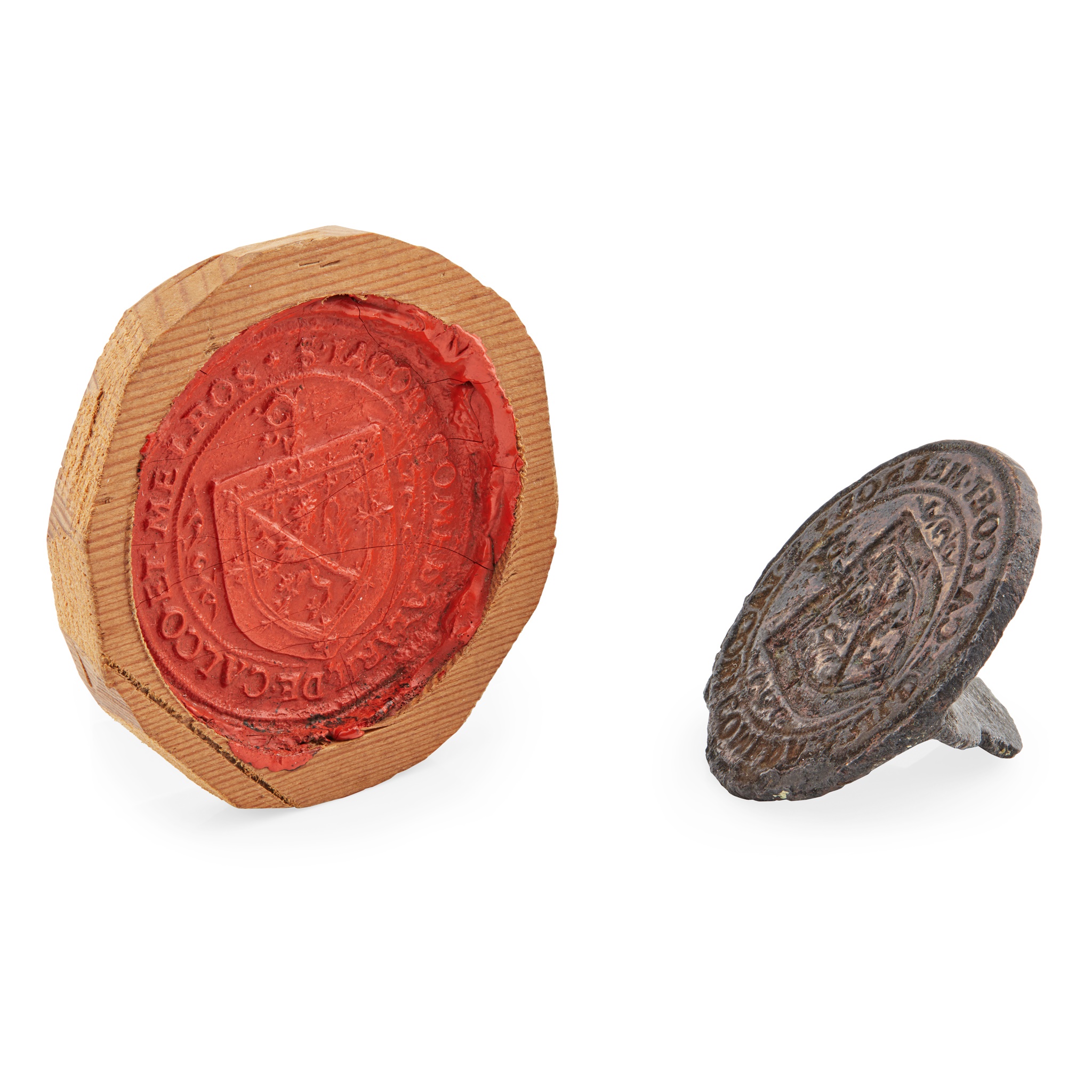THE JAMES STEWART, COMMENDATOR OF MELROSE SEAL MATRIX
AN IMPORTANT SCOTTISH 16TH CENTURY SEAL MATRIX, CIRCA 1535 - 1541
£6,250
Auction: 9 March 2021 at 10:00 GMT
Description
the circular matrix engraved with the arms of James Stewart with motto S. IACOBI.COMEDATARII.DE.CALCO.ET.MELROSE around, with integral flange handle to reverse, with manuscript label ‘GIE H&A 1901 290’
Dimensions
Diameter: 4.1cm, weight: 44.4g
Footnote
Heraldry:
With the arms of James Stewart (born c.1529 – 15th September 1557) of an altered Royal Arms of Scotland debruised with a bendlet to denote illegitimacy, the arms are resting on a crosier to denote his office of Commendator of Kelso and Melrose.
Exhibited:
Glasgow International Exhibition of Scottish History & Life, 1901, item 317
Provenance:
C.H. Scott Plummer collection, since at least 1901
By direct family descent to current vendor
Notes:
This Scottish seal is not only a remarkable survival from the 16th century, but one connected to the Royal House of Stewart. James Stewart (born c.1529 – died 15th September 1557), son of Elizabeth Shaw, was the eldest of at least nine illegitimate children of King James V (1512 – 1542).
Of James V’s illegitimate children four of the six males were named James / John presumably to show the connection to their father even if they would not benefit from Royal titles or privilege. However, this seal proves that the illegitimacy of the sons did not stop King James from bestowing titles and positions of power, and likely wealth, upon at least some.
Bestowed by his father, James Stewart’s position as Commendator of the Abbeys of both Kelso (1534 – 1557) and Melrose (1535 – 1557), in the Scottish Borders, puts him in a very high position. Not only one of power overseeing the lands of the Abbey and the wider areas but in control of financial and local security.
The position of Commendator is bestowed upon a qualified person over a vacant benefice of a church or abbey. The Commendator retained the living from the position most commonly until being replaced when a suitable cleric became available. The practice was abolished by law in 1836.
It appears that James Stewart was granted the Commendatorship of Melrose in 1535 but it is possible that this seal was not made until 1541 when the last Abbot of Melrose, Andrew Durie, who had served from 1525 stepped down to become Bishop of Galloway. While Stewart held the position from 1535 it is likely that this was more in title than function until this point which would in turn have necessitated a seal being created.
By King James placing one of his illegitimate sons in this double roll it not only promotes and finances his life (much closer to that of a legitimate Prince) but protects the King’s interest in the areas under his son’s control. At a time when peace with the English Royal family was tense and fragile having as widespread support was undoubtedly important. It is by no means coincidental that these positions were granted in the Scottish borders.
This seal relates exclusively to James Stewart’s work as the Commendator of Melrose Abbey. While it has not been seen on the open market in at least the last century it was exhibited in the 1901 Glasgow International Exhibition. This exhibition brought together a remarkable cross section of Scottish history from early to modern times. The exhibitions of medieval and early modern Scottish art and relics arguably have rarely been surpassed. Drawing from personal and institutional collections some of the most important relics of the nation’s history were exhibited.
While no other reference to this seal being exhibited can be found, it is interesting to note that it appears that two wax impressions of the seal are within the collection of the National Museums of Scotland (H.NM 253.1 and H.NM 253.2 both dated circa 1541 perhaps adding weight to the possible later date of production of the seal). However, their date and origin are not recorded on the online catalogue so they may be from original documents or Victorian impressions made as historical trinkets.
It is recorded that James Stewart’s seal from the Abbey of Kelso is known. This seal appears to have taken a much more elaborate design with more architectural feature and ecclesiastical emblems rather than personal heraldry. The current whereabouts are unknown but it is described fully in ‘History of Scottish Seals, Volume II Ecclesiastical and Monastic Seals’ by Walter De Gray Birch LLD FSA in 1907.
While various early Scottish seals - personal, royal and burgh - do survive, the vast majority are within institutional collections. Either residing within their original corporation, institution, or museum collections. Rarely do any pre-1700 Scottish seals appear on the open market let alone from the mid-16th century.
That said, two highly important examples have been offered in recent years. The earliest Scottish silver seal by David Milne of Edinburgh 1613-14 for the Burgh of Easter Anstruther, sold Lyon & Turnbull Scottish Silver 16th August 2011 lot 105 (£37,250 inc. premium) and an important cokete seal matrix pair from the Abbey of Dunfermline in the reign of Robert the Bruce, sold by Timeline Auctions 2014 (£151,250 inc. premium).

